The first time I went to Pasar Badung I was so overwhelmed by its size I didn’t even go in. I’d ojeked into Denpasar from Ubud for the day to scope out somewhere to live. In Bandung my shoe box boarding house room was eight minutes’ walk from work and there I walked everywhere, or took an angkot (hop on, hop off beat up old mini buses trundling set routes throughout the city and its outskirts). Foolishly I assumed I could do the same in Denpasar, forgetting its perpetual humidity and without realising the island has a distinct absence of angkot. After four nights in a cheap Denpasar hotel (a yellowed sign at reception warned ‘No guests who not your wife after 10pm’) and four days of increasing impatience with the ceaseless city traffic while pining for Bandung’s blissful breezes and broad sidewalks, I hot-footed it east to Sanur and accepted the fact I was now a commuter. But I quickly grew to love that 25-minute ojek ride, as each morning when Bali’s biggest and oldest traditional market loomed large beneath my helmet, I beamed. What delights will I discover today?
After my first day at Yayasan Rama Sesana (YRS) on Pasar Badung’s top floor, I was astonished to find its bottom floor had spilled out into the parking area in a congested mass of fruit and veg stalls, with capacious sacks of canang sari (Balinese offerings) squatting at every corner, their concentric circles forming beautiful flower mandalas. Pasar Badung was open 24/7; at 4pm its four storeys would shut and the vast car park was replaced by the pasar malam, the night market. I’d witnessed it briefly at 4am a few days before, from a taxi while en route to the Australian Consulate-General’s Anzac Day Dawn Service. I was equally astounded then by the thousands of women surrounded by a sea of swollen plastic bags and bulging baskets. It seemed Pasar Badung fed the entire Denpasar metropolitan region’s two million residents. And there was my office on the top floor! Whenever I told a Balinese I worked at Pasar Badung they’d crack an incredulous grin. “Punya toko!?” You have a shop!? I’d then explain ardently about YRS and encourage them to drop in.
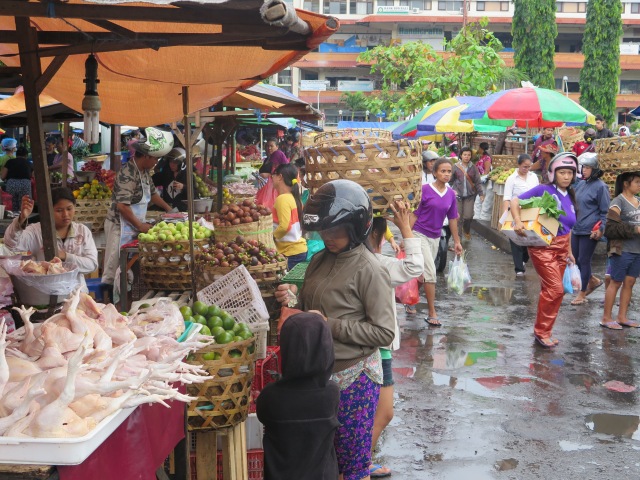
Wandering wide-eyed in the market after my first day of work, I snapped away like a tourist
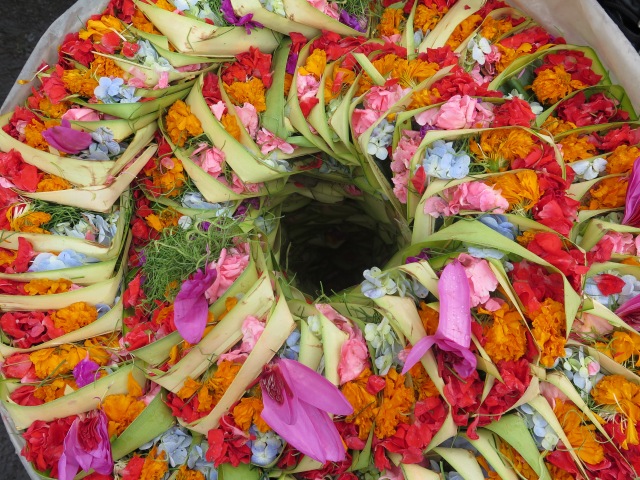
Canang sari

Musim rambutan dan manggis, rambutan and mangosteen season
During lunch breaks I wandered lantai dua (the second floor) or lantai tiga (the third floor). Lantai dua was a labyrinth of cheap clothing stalls and narrow lanes cascading with Balinese endek, Javanese batik and lacy kebaya. The vendors grew to know me and my lunchtime meanderings and their “Yes? Looking my shop?” soon became “Ah, istirahat” (break time). My favourite was lantai tiga, for its almost impenetrable jumble of vibrant Balinese Hindu paraphernalia, bamboo household items and hundreds of bags of snacks stacked liked forts amid pungent piles of dried fish and dusty spices. It was hide-n-seek heaven.
For this traditional market lover there was old magic in metre-long kayu manis (sweet wood – cinnamon) bundled like kindling for a fireplace, and mice-nibbled sacks of strange seeds, like pumice acorns. I’d buy half kilo bags of emping manis and kacang kapri from Ibu Kadek Era, and each time she’d teach me a few words in Balinese. But the chaotic bricolage of rattan boxes, bamboo baskets, plates and brooms often made me think ‘fire trap’, as did the tonnes of polyester clothing and cheap textiles below.
Every Monday after work I’d do my week’s grocery shopping. I had a favourite Ibu for vegetables, Ibu Remben, and a few favourites for fruit, depending on the season. Some Mondays Ibu Remben was all smiles while on others she was stoic, handing me my change across cabbages and cucumbers without a glance. I’d load up with carrots, pale yellow baby corn, ripe cherry tomatoes, perhaps some slender snow peas, maybe some wood ear mushrooms. What I relished most were her proud red paprika merah (red capsicum), which no other vendor seemed to stock.

Ibu Remben. Photo: Pande Parwata
To the right of her table was a pork meat stall with a meat hook stand at the back. The stand was just like a hat stand with heftier hooks on which long slabs of ribs were skewered. The stall’s table was layered with pigs’ ears the size of small papaya, and sometimes I’d glimpse a few face skins draped over the rim of a bucket, perfect pig masks. The thunk thunk thunk of the cleaver often punctuated my requests for “paprika merah, dua”. I’d then make a beeline for my mango lady, who always called me sayang (darling). For four glorious months I devoured harum manis (sweet aroma) mangoes. They were Rp12,000 a kilo, about $1.20. As mango season began to fade buah naga merah (red dragon fruit) appeared; the sweet spot when they were both in season was bliss. Would I ever again work in a place as colourful as this?
*
At about 6pm on Monday 29 February I was at my little desk by my lone window when Dr Sari, the founder and director of YRS called. “Julia! Pasar Badung kebakaran!” she shrieked. “Kebakaran di Pasar Badung!” Fire. I could only manage “Aduh Dok di mana!? Di atas?” before she hung up. I’d never heard her frightened. For the next three hours I trawled Twitter staring hard at the photos, my distress deepening as the sky darkened and the fire grew more ferocious. Gunmetal grey clouds billowed above and burst from the eaves. I lost all hope anything would be left of our clinic and when I closed my eyes to sleep I saw flames consuming the kacang, the bamboo baskets, the batik, racing up the poles of the ceremonial umbrellas and dissolving the saffron satin in furious orange flashes. That night I awoke every few hours, each time reaching in the dark for my phone to trawl Twitter. At 3am the fire still wasn’t extinguished and I could barely believe the reported number of fire trucks at the scene: 15.

At about 9 the next morning Dr Sari called. She’d been at Pasar Badung until 2am, then returned six hours later. After 17 hours the fire was finally out. Miraculously, while the first three floors were completely destroyed, the top floor’s west wing, where our clinic and office were, wasn’t consumed by flames. Dr Sari later told me many of the pedagang (vendors) told her the reason why our clinic wasn’t destroyed is because of all the good work done within its walls. She emailed me her action plan to edit and send to our supporters; YRS would increase the frequency and range of its mobile clinics while searching for a temporary home. She was determined to continue YRS’ programs. I was breathless with awe.
Two days after the fire our staff evacuated what they could from our clinic and office. Most of our medical equipment had melted, but some office equipment was still alive. I was eager to help, but as we were receiving information requests and grief-filled messages from donors and supporters Dr Sari asked that I stay home to handle the comms. She sent a photo which tore at my heart. Hundreds of pedagang huddled knee-to-knee in the Pasar Badung basement, listening to market management and local government about their relocation, which most were dead against. If they start trading away from Pasar Badung, what is the guarantee their space won’t be taken by someone else when it reopens?
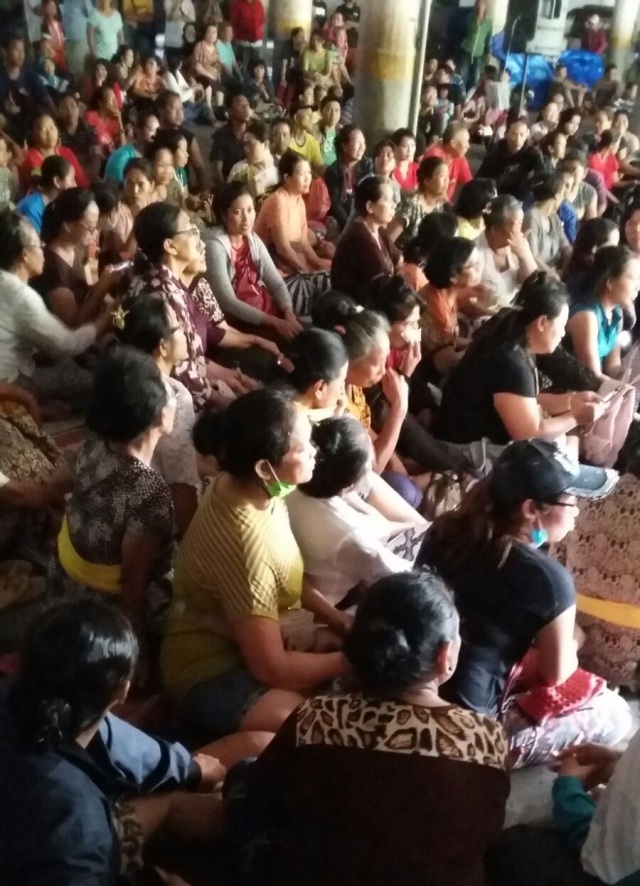
Three days after the fire I met Dr Sari at our small clinic at Pasar Intaran in Sanur. Before the fire it was only open on Tuesdays and Thursdays, but now it would open Monday to Friday. The night before I’d slept fitfully, afflicted by acidic anxiety because my assignment end date was 25 March, just a few weeks away. After that I would explore Flores for the best part of a month before flying home to Alice to volunteer at Wide Open Space Festival, which my brother was performing at and many old friends were attending. I’d then head to Melbourne for my Uncle’s 60th. But how could I leave YRS now? When I told Dr Sari in our little Sanur clinic that I would apply for a one-month assignment extension she leaped from her chair and threw her arms around me, then burst into tears. I’ve never felt more like a volunteer.
*
On 13 April I returned to Pasar Badung for the first time since the fire. A couple of weeks before on my way west to Canggu I passed the road parallel and my throat seized up. I knew the response I’d have if I faced Pasar Badung, and so I simply avoided it. But that day Kompas TV were filming Dr Sari and YRS staff speaking to vendors about their experiences of the fire and conducting outreach, so naturally I had to attend. Before meeting my colleagues I planted my feet firmly on the ground and stared up at the blackened building. I cried behind my sunglasses. It was a huge scorched shell. Where once there was a kaleidoscope of colour in almost every square metre, now there was only black.
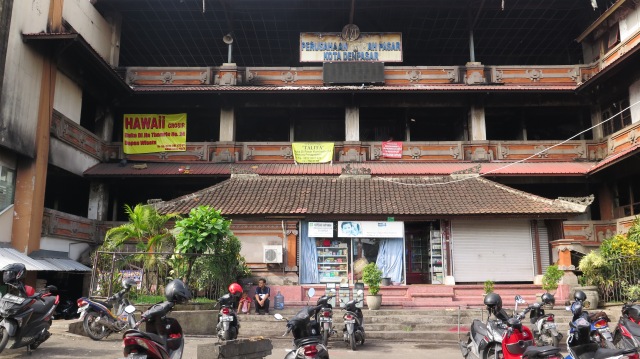
43 days after the fire
In the basement and in the parking area a market had arisen; clothing and jewellery below and everything else above. The patchwork canopy of tarpaulin washed the stalls in watery blue. I smiled wide as Dr Sari chatted with the vendors. One woman joked she’d ‘sold’ all her stock to the fire, another jibed that it helped her cleanse her stall of stale biscuits and crackers which she’d been ‘too lazy’ to do. I was thrilled to see Ibu Kadek Era again, and admitted to her it was the first time I’d returned since the fire because before I was “belum berani” (not yet brave enough). She mimicked my “kasihan pedagang” (those poor vendors) with “Kasihan pedagang? Beli lebih banyak kacang!” You feel sorry for the vendors? Buy more peanuts! I left with a wry grin and two kilos.


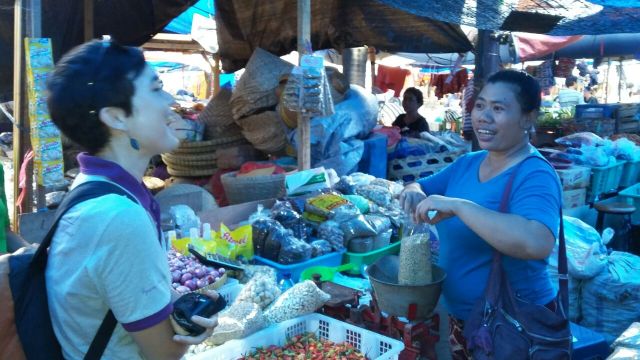
“Beli lebih banyak kacang!“
With a few colleagues and the Kompas TV reporter I then returned to our clinic. All that remained were broken tiles and rubble. The shriveled plants made my heart ache the hardest.


The front of our clinic a few months before the fire. High fives as Dr Sari and I had just finished our Five Year Strategic Plan, which was a major part of my role
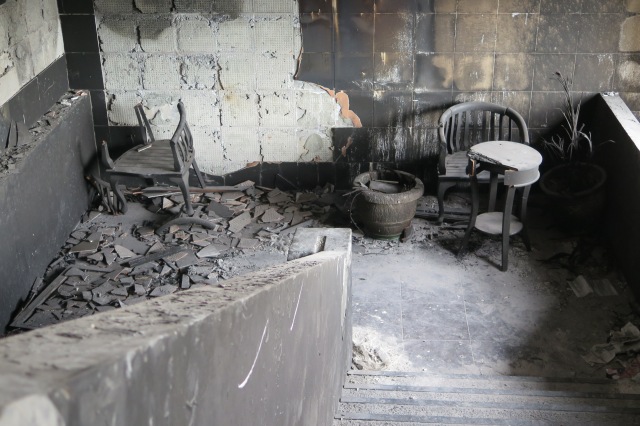
Sometimes I’d sit in this chair on lantai tiga…

…and look out at this view

Picking through the remains of lantai dua this ibu proudly displays a relatively untarnished quilt
Later that afternoon when Dr Sari arrived at our temporary office she said softly and slowly, “Those women are an inspiration to me. Despite everything they are still smiling.” Dr Sari has been running YRS virtually non-stop for the last 12 years. In all that time she hasn’t had a holiday, not even an extended break. Last week Coconuts Bali listed her among “11 Badass Balinese history makers” alongside Gusti Ngurah Rai, a national hero and face of the 50,000 rupiah note. As I say in this video which has become a treasured memento of that market’s wondrous colours and smiles, working closely with her has been a blessing, and even more so after the fire.

Photo: Conor Ashleigh
Postscript
At the time of writing, the local government is due to conduct a ballot for the relocation of 167 vendors to Tiara Grosir, a wholesale warehouse two kilometres north of Pasar Badung. There were 1,683 stalls in and around the market before the fire. The cause of the fire is still being investigated and is widely considered misterius. According to local press 34 witnesses have been questioned, but none have been able to provide significant information.
All YRS’ administrative duties are now being conducted at our Secretariat in Sesetan, southern Denpasar. Until the Pasar Badung vendors have been relocated we are unable to search properly for a new base clinic, although we will be provided with a small space at Tiara Grosir so we can conduct outreach and small group discussions.
The national government will be in charge of coordinating the demolition and rebuilding of Pasar Badung. It is rumoured this will take about two years. YRS will return to the market when the time comes, and Dr Sari has requested space on the ground floor, rather than the top floor, so staff no longer have to carry heavy medical equipment up four flights of stairs.
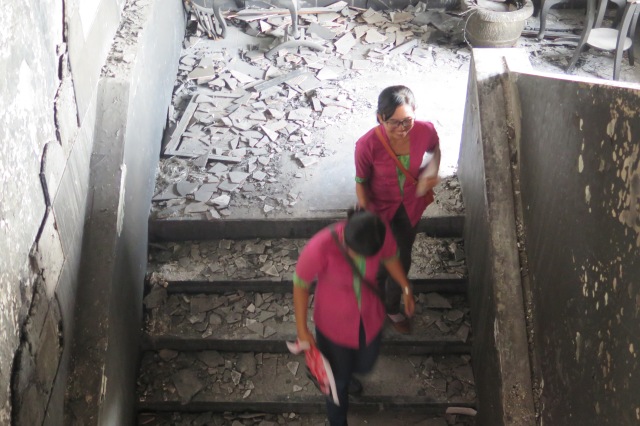
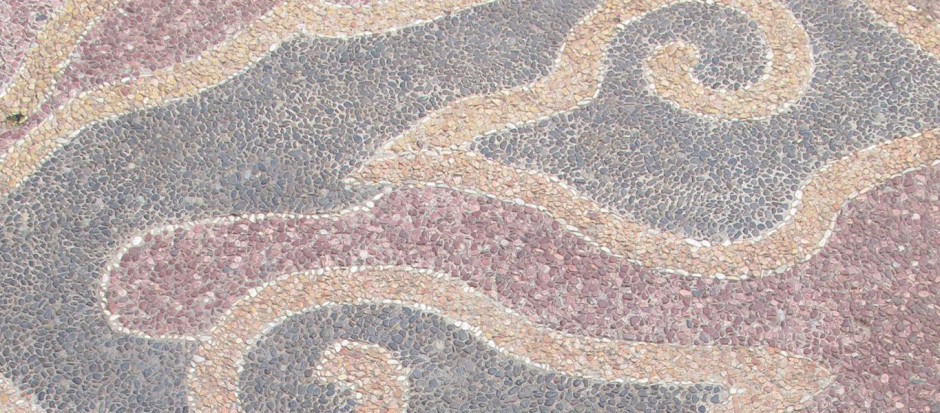
Wow, Jules, this is an amazing story. Your writing is beautiful; I could feel the emotion. It is great to so so many strong women supporting other women. You are doing great work xx